



credit: EventHubs
Related posts:
]]>


credit: EventHubs
Related posts:
]]>
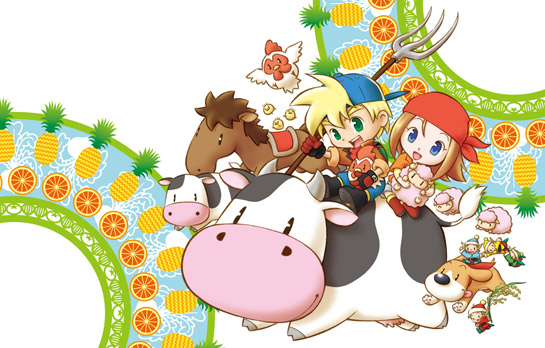
“We are always trying to do something different from the other publishing companies. Having a distinct marketing strategy is our concept, which is to say we are not trying to do the same thing as the other publishers are trying to do. For example, whenever a company brings out a big racing game, other companies follow suit, but we don’t do that. Our specialty is a niche marketing strategy with a focus on the types of games that other companies would not bring over here. These are titles that they’re afraid to bring here because they feel the market is too small.”
Through past experience, he knows that many titles that other companies/publishers would never even consider have the potential to make an impact over here -
“There is for example, our popular Harvest Moon franchise. When I came from abroad with Harvest Moon almost 11 years ago, I was still a newcomer to this industry. So I asked a lot of advice from other companies in this business. They said, ‘Don’t bring it (Harvest Moon) into this country, it’s so boring!’ They felt back then all American gamers were playing fast paced shooting and action games.”
“I was not a good gamer at the time. I came from a completely different business. But when I played Harvest Moon for the first time, I felt this game might have great potential. It might seem boring, but it’s quite niche. America is a huge farming country and this series is not only a farming game, but it also shows the rewards of hard work. So my instinct was that this game might have great potential to grow. That is one of our marketing strategies. Nobody was interested but we believed strongly in it. (laughs) When I say “we” I mean “me” because I was the only person in here at the time. So the only people I could consult with were business minded people from other Japanese companies publishing in the U.S.. None of them gave me any good comments, ‘If you bring it Harvest Moon here, it will be a sad mistake.’”
But Hiro is also aware that Natsume has to be smart about which titles it decides to bring over. In a follow-up piece, he uses Taito’s Densha de Go series to explain how cultural differences have to be taken into consideration -
“But you cannot bring every kind of niche game from Japan into the U.S . One perfect example are those very popular Japanese train simulation games like Densha Da Go. Yes, the U.S. does have trains and subways, but its transit infrastructure is quite different than that of Japan’s. You would have to change the game’s style very much. This brings up one of my most important points about being a Japanese company in the U.S.: you have to be bi-cultural. Sure we’re niche as I mentioned before, but a company like Natsume has to also consider American tastes. We have stay successful by staying with these philosophies.”
Related posts:
]]>
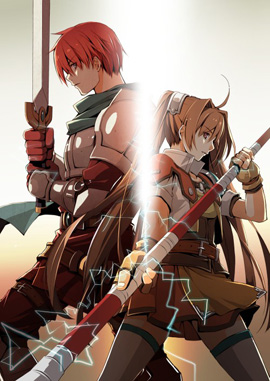
|
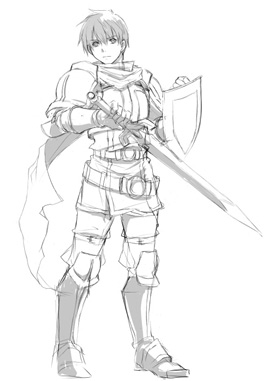
|
| Adol Christin (Ys series) – The main character in the series (except for Ys Origin). He’s a generally nice guy that is good with a sword. |

|

|
| Olha (Ys VI: The Ark of Napishtim) – A priestess who was saved by Adol. She probably has some feelings for him. |
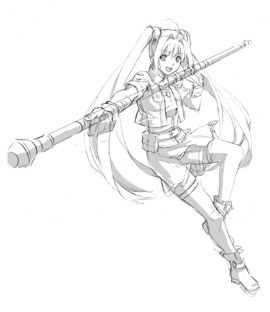
|
| Estelle Bright (The Legend of Heroes VI: Sora no Kiseki) – The main female character in Sora no Kiseki. She is known for being tomboyish. |
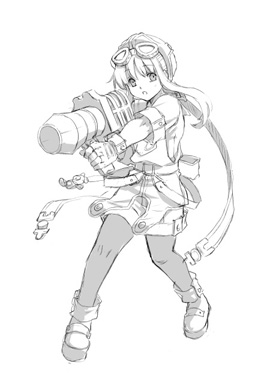
|
| Tita Russell (The Legend of Heroes VI: Sora no Kiseki) – Though young, she is very skilled with machinery. |
No related posts.
]]>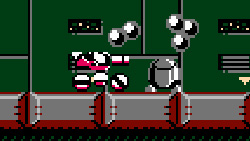
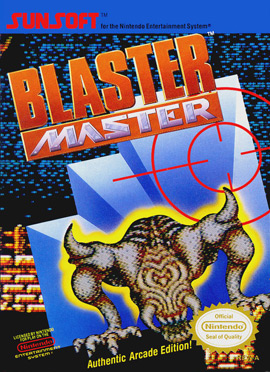
game: Blaster Master
composer: Naoki Kodaka
where: Area 3
Related posts:
]]>

Related posts:
]]>

Victor Ireland, former president of Working Designs, the founder of Gaijinworks, and someone who was instrumental in getting this collaboration started, has been reaching out to the community through NeoGAF and Sunsoft’s own fan forums. Here are a few of the things that he had to say about the upcoming release -
on Blaster Master
“There’s some cool (as in unique – hello workling designs!) promotional things available for those that buy the VC version. There’ll be details on the website around the launch of the game.”
on beating Blaster Master
“You’ll be rewarded for making the effort this time around.”
Redding, CA – December 14, 2009 – Sunsoft, a division of SUNCORPORATION, has today announced that Blaster Master is available in the United States on the Wii Virtual Console.
Originally titled Meta Fight in Japan, this groundbreaking game was given a story makeover and released in 1988 as Blaster Master here in the United States. It received strong critical acclaim and fan raves almost from the moment it hit these shores.
Blaster Master is still often listed on magazine and online charts as one of the top 25 NES games ever created. The sublime blend of side-scrolling shooting/platforming mixed with overhead perspective action/shooting areas is just as addictive now as it was then. The smorgasbord of old-school entertainment can be had for a mere 500 Wii points.
Fans are encouraged to improve their skills so they can finish this supreme test of gaming skill to allow them to take part in a coming promotion that will test their skill for prizes.
from Sunsoft’s Blaster Master VC launch page:
Originally titled Meta Fight in Japan, this groundbreaking game was given a story makeover and released in 1988 as Blaster Master here in the United States. It received strong critical acclaim and fan raves almost from the moment it hit these shores.
Blaster Master is still often listed on magazine and online charts as one of the top 25 NES games ever created. The sublime blend of side-scrolling shooting/platforming mixed with overhead perspective action/shooting areas is just as addictive now as it was then.
Here’s the charmingly 80’s description from the back of the box as it appeared in 1988:
The New York sewers were never like this!
You’ve fallen down a hidden manhole into a world of creatures so terrifying they’d scare the rats away. You can panic and perish, or blast your way through an endless maze of tunnels, searching for the secret passages to your escape.
And, that’s the easy part. Because the Masters of the Caverns lay waiting – prehistoric creatures so powerful, so gigantic, they literally fill your screen! So load your arsenal and get ready for Blaster Master.
Now you can revisit this arcade-action classic on your Wii and revisit a time when games were only finished by the best, and only the best games got finished.
Arrival Date: December 14, 2009
Platform: Wii Virtual Console
Cost: 500 Wii Points
Related posts:
]]>

After years of false hopes and shattered dreams, the Sakura Wars video game franchise is finally set to make its US debut on March 23, 2010 with NIS America’s release of Sakura Wars: So Long, My Love for the PS2 and Wii.
According to the press release that was sent out today, PS2 owners will have a chance to purchase a premium box set that contains an art book, poster, collectible outer cover, as well as a second copy of the game with Japanese voiceovers. Though the Wii release will only come in English, it will be offered at a much lower price point. The idea is that the hardcore fans have the option to get more by paying a little extra while those who are somewhat interested in the series could try it without breaking the bank.
I’ve been told that the premium box set will only be available during the game’s first run. If/when the second shipment goes out, it will only contain the English version. So, if you really want to play Sakura Wars V with the original voicework, make sure that you get it as soon as it’s released.
Santa Ana, Calif. (Dec 11, 2009) –The year 2010 marks the arrival of the highly anticipated PS2 & Wii SRPG Sakura Wars. NIS America has announced that Sakura Wars will be hitting stores on March 23, 2010. For long time fans of Sakura Wars and SRPG fans, the PS2 premium box version will include a special art book, poster, and a collector’s item outer cover. The PS2 premium box version will also come with a double dual layered disc, each featuring the respective voiceovers of either English or Japanese. If you are looking for a killer bargain though, the Wii version will be a single dual layered disc with English voiceovers. This version does not contain the bonus items, but will be offered at an attractive price point.
About Sakura Wars
Sakura Wars is a Strategy RPG that features a unique, sim-based story system. An in-depth storyline exists, much like in any other RPG; however, the player’s destiny in the game is not predetermined. Character interaction plays a major role, and your responses to the various characters in the game can ultimately change the story content and even the final outcome.Battle System
The battle system is divided into two main parts; ground combat and air combat. Ground combat takes place using two-legged mechanized suits, which transform into jet fighters to take the fight to the sky. Every mechunit in the game can transform from battle mechmode to jet fighter mode during combat. Once transformed, weapons and movement methods will change as well. For example, the hero’s ground mode utilizes a sword as his main weapon, but in jet mode he will use long-range missiles.RELEASE DATE: 3/23/2010
PLATFORM: PlayStation 2, Nintendo Wii
GENRE: SRPG
PLAYER(S): 1
ESRB: RP
PUBLISHER: NIS America
DEVELOPER: SEGA, RED, IDEA FACTORY
Related posts:
]]>
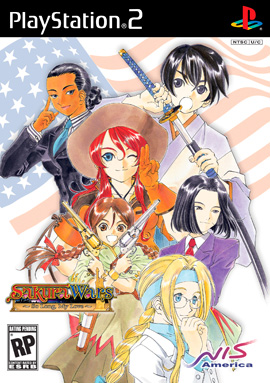
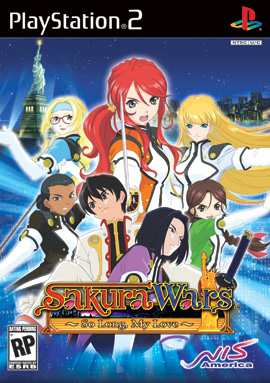
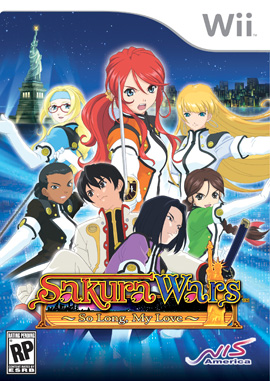
|
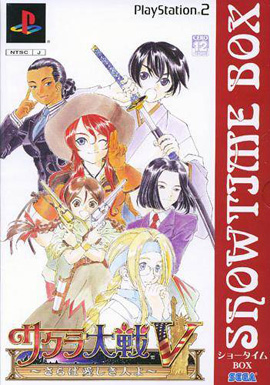
|
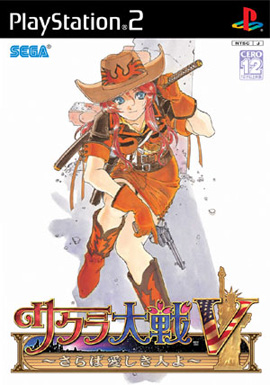
|
Related posts:
]]>
Daikuugun (PSP)
Family Trainer 2 (Wii)
Horrid Henry (Wii) [Europe]
Samurai Spirits Sen (360)
World Soccer Winning Eleven 2010 (PS2, PSP, Wii)
Bookworm (DS)
Dirt 2 (PC)
East India Company: Battle of Trafalgar (online) (PC)
Flowerworks (Wiiware)
James Cameron’s Avatar: The Game (PSP)
PixelJunk Shooter (PS3 downloadable)
Puzzler World (DS)
Salon Superstar (DS)
Tales of Monkey Island Chapter 5: Rise of the Pirate God (online) (PC)
The Saboteur (360, PC, PS3)
Your Shape (PC)
Related posts:
]]>
Redding, CA – December 4, 2009 – Sunsoft, a division of SUNCORPORATION, has today announced their return to active console game publishing for the North American market, aided by startup GAIJINWORKS.
Kiharu Yoshida, CEO of SUNCORPORATION initiated a meeting to discuss the possibility of reinvigorating the Sunsoft console gaming brand in the USA. At that meeting, it was quickly obvious that the relationship was a great fit. GAIJINWORKS President, Victor Ireland states, “My relationship with Sunsoft and Yoshida-san goes back more than 15 years, and when this opportunity presented itself to help Sunsoft return to the US console market, it was a natural fit for both our companies.”
This month, the Sunsoft website is being re-launched at sunsoftgames.com, where users will be able to get the latest information about current releases, upcoming games, and special promotions, as well as interact in the forum. Kiharu Yoshida wanted gamers to know that Sunsoft plans to launch a number of special promotions where big prizes can be won, and exclusive, limited edition premiums would be up for grabs as well. Ireland added that some of the swag being made would only be available through these promotions – and is sure to please Sunsoft fans, new and old.
The first title out of the gate for Sunsoft USA will be the Wii Virtual Console release of the Nintendo Entertainment System classic Blaster Master, due in December 2009. Originally titled Meta Fight in Japan, this groundbreaking game was given a story makeover and released in 1988 as Blaster Master here in the United States. It received strong critical acclaim and fan raves almost from the moment it hit these shores.
Blaster Master is still often listed on magazine and online charts as one of the top 25 NES games ever created. The sublime blend of side-scrolling shooting/platforming mixed with overhead perspective action/shooting areas is just as addictive now as it was then. It will be available for 500 Wii points.
In the coming weeks, additional titles coming to the US market will be announced, many of which will surprise and delight gaming fans. Ireland added, “This first Wii release is a great start, but there is one upcoming announcement in particular that will demonstrate just how serious Yoshida-san is about rebuilding the Sunsoft console gaming brand here. Game fans are going to be pretty happy when they hear about it – I know I was.”
About SUNCORPORATION. Located in Aichi prefecture in Japan, SUN CORPORATION has been innovating electronic equipment and software for almost forty years. Their corporate slogan, “Dream, Challenge, and Creation” perfectly summarizes the spirit that gave birth to their software company Sunsoft. Worldwide, Sunsoft has developed or published almost 100 games for both consoles and arcades. They also publish for iPhone and Windows mobile platforms.
About GAIJINWORKS. GAIJINWORKS was founded by Victor Ireland after spending more than 15 years as President of Working Designs, where he innovated deluxe packaging, special premiums, pack-in soundtracks and game documentaries for their RPG product. Many of the practices he innovated have become standard in the RPG segment, and console video games in general. GAIJINWORKS is focused on continuing a tradition of fanservice for game fans.
Related posts:
]]>
1500DS Spirits Mahjong V
Honki de Manabu: LEC de Goukakuru – DS Koumuinshiken Suumato Shori
Isometric & Karate Excercise Wii de Kotsuban Fitness
Jinsei Game DS
Kamo no Hashikamo. Aimai Seikatsu no Susume (DS)
LittleBigPlanet Portable (PSP)
New Super Mario Bros. Wii
Shin Noukyo Iku (DS)
Signal (DS)
Tokyo Friend Pack II Ketteiban (Wii)
Alvin and the Chipmunks: The Squeakquel (DS, Wii)
Avatar (360, DS, PC, PS3, Wii)
Copter Crisis (Wii downloadable)
Elven Legacy: Magic (PC)
Empire Deluxe (DS)
Picture Perfect Hair Salon (DS)
Learn Science (DS)
MX vs ATV Reflex (360, DS, PS3, PSP)
Rec Room Games (Wii)
Rogue Warrior (360, PC, PS3)
Storybook Workshop (Wii)
Strike Force: Red Cell (PC)
th!nk Logic Trainer (DS, Wii)
th!nk Logic Trainer: Kids (DS)
The Lord of the Rings Online: Siege of Mirkwood (PC)
The Seventh Dragon (PC downloadable)
Zombie Driver (PC downloadable)
Related posts:
]]>
Capcom obviously noticed how good GGPO is since the company took it upon itself to secure a multi-year, multi-game license for the technology a while back. Oddly, it wasn’t used in HD Remix, Street Fighter IV, or the recent Xbox Live! and PSN versions of Marvel vs. Capcom 2. But, according to a recent post over at the Capcom Unity Blog, GGPO netcode will be used in the upcoming Final Fight: Double Impact arcade compilation.
Related posts:
]]>


Related posts:
]]>
1500DS Spirits Shougi V (DS)
Center Shiken Eigo Listening Sokushuu DS
Cooking Mama 3 (DS)
Eiken Kansei Han (DS)
Gakken Eigo Sanmai DS
Gakuen Heaven: Boy’s Love Scramble! (PSP)
Just Dance (Wii) [European]
Karaoke Joysound Wii DX (Wii
Ochaken no Heya DS 4: Ochaken Land de Hotto Shiyo?
Puyo Puyo 7 (PSP, Wii)
Wheelspin (Wii) [European]
Bit.Trip Void (Wii download)
Cocoto Surprise (Wii)
Coldstone: Scoop It Up (Wii)
Fighting Fantasy: The Warlock of Firetop Mountain (DS)
Hello Kitty: Party (DS)
Karaoke Revolution (PS3, 360, Wii)
King Arthur: The Role-Playing Wargame (PC)
Madden NFL Arcade (360 download, PS3 download)
Mystery Case Files: Dire Grove (PC download)
Rogue Trooper: The Quartz Zone Massacre (Wii)
Scene It? Twilight (Wii)
Tekken 6 (PSP)
Your Shape (Wii)
Related posts:
]]>

Take a look at the cover art up above. The fairytale setting features a king, a princess, an old knight on a cow, a dragon, farm animals, and townsfolk going about their everyday lives. It’s an image that hints at a family-friendly game that children and their parents can enjoy together. But if one were to look past the fuzzy feelgood picture and take a closer look at the actual game, he or she will find that it belies Little King’s Story’s true nature – that of a hardcore game with story elements that brush up on taboos that nobody would expect.
Much of the story is told through dialog between Corobo, his friends Verde and Liam, and Howser, his adviser. There are also a few minor characters here and there that will offer their thoughts on what is going on as well, including the princesses, a religious nut, a scientist who isn’t right in the head, and, of course, the citizens of your kingdom. There certainly isn’t as epic a story as one would find in your typical RPG, but there are enough plot twists that happen during the course of Little King’s Story that help to keep things interesting. And I must say that the final twist – the explanation for all the weirdness that you see throughout the game – made for one of the most memorable endings that I’ve seen in a long time.
Party members will fall into one of three formations once recruited – attack, guard, and evade (you get the attack formation when you start out and learn the other two later). With attack, your party members form rows behind you. As you turn, they will do their best to maintain the formation. It is actually quite satisfying to see an attack coming, position yourself in a way that keeps your party members from being hit, completely avoid the attack, and then counter attack. Guard has your loyal followers forming a circle around you. While I found it useful for some of the more hectic battles, I usually just stuck to attack. One problem with the guard and attack formations is that because your followers are spread over a large area when using said formations, they will often get stuck behind walls or fall off cliffs. Since their pathfinding abilities leave much to be desired, you will either have to go back for them or keep going and wait for them to magically reappear later. This problem can be avoided by using the evade formation when you are not in battle as with evade your minions will all follow you in a single-file line.
Since the game does not make use of the Wii’s IR functionality, aiming is done by either eyeballing it and hoping that you get lucky or by activating Target Mode, an option that creates a line with which you can determine your line of fire. The line automatically locks on to nearby objects, which is a great help since it takes some of the guesswork out of aiming. Pointing the line at something also reveals how much energy it has or how much work is required to clear it, so there really is no reason not to use Target Mode all the time. For the most part, Little King’s Story’s pointerless controls work very well. I will admit that there were times when I thought that having a pointer would have been nice – more than once I found myself dodging an attack, quickly turning to face my opponent, and launching everything I had only to find that I was not locked on, which led to me missing an opportunity to do major damage. It’s no deal-breaker for sure and if there was ever a sequel I’d rather the developers keep things the same and just improve the lock-on accuracy, but having the option to use the pointer for emergencies might be nice.
In the beginning, all of the citizens are merely “carefree adults” who can only dig holes. Once enough Bol (Little King’s Story’s form of currency) has been acquired and the correct buildings have been built, they can learn different jobs. As one would expect, each job class allows workers to do some things better than others. Farmers, for example, can dig holes faster and are more likely to find better items. Soldiers, on the other hand, cannot dig and are only suited for combat and destroying things. Farmers can attack as well, but they are not as effective as soldiers. While you can teach someone a different job at any time, learning costs money (with the exception of farmers and soldiers). So, you can’t go around changing professions on a whim. As you explore the world outside your kingdom you will often run into obstacles that cannot be overcome until you have access to certain jobs. Fortunately, more job types will show up as you expand your territory. As a result, you will often find yourself going back to places that you had already visited in order to open up new areas. Fans of Super Metroid and Castlevania: SOTN-style backtracking will appreciate how well the mechanic works here.
Deciding who to bring along is easy enough when you start out since there are only a few people and professions to choose from. Unfortunately, forming the perfect party becomes a chore once you expand your kingdom since your citizens tend to move around a lot. This can be remedied by purchasing the podium, an upgrade that allows you to call your citizens to you. With it, you can bring up your current party, otherwise known as your royal guard, or call citizens who have jobs in some preset categories such as “battle,” “cultivation,” and “construction.” You still have to manually add new party members with the recruit command, so unless you are forming parties that only contain one specific job class, recruiting remains tedious. Fortunately, a much easier way to form diverse parties exists in the form of the podium’s citizen list. With it, you can add and remove royal guard members by going through a list that can be reordered by categories like “job,” “name,” and “life.” While an improvement over manually recruiting, it is still unintuitive and time consuming. Assigning power-up items to members of the royal guard is equally frustrating. All this wouldn’t be so bad if you at least had the ability to save your favorite party configurations. But, since there is no such option, you are forced to reform your parties from scratch all the time.
If you aren’t walking around town or exploring the outside world, you are probably in your castle deciding what your next move will be. Luckily, you have your three ministers on hand to help you out. Records Minister Verde is who you go to when you want to check on the status of your citizens. She will show you demographic information like population numbers, what your citizens think about you, and job distribution. She is also the one that you go to when you need to save your game. Anything Minister Liam is essentially the in-game manual – he will tell you all about how to control Corobo, what each job does, the differences between the three formations, and much more. You can go to him when you need to equip your royal guard as well, but his usefulness in that department goes away once you get the podium; you will have no need to talk to him once you learn how things work. Bull Knight Howser is the most important person in your close circle of friends as he is who you go to for starting quests, getting tips on defeating your major enemies, and constructing buildings or buying upgrades.
When you talk to Howser about new missions, he will present you with letters that your citizens have sent to you by way of suggestion box. Most of them ask you to seek and destroy UMA, but every once in a while you’ll get some odd ones like meeting other people, finding items, and paying your ministers for all their hard work. The UMA extermination missions will start to repeat themselves after a little while (though the wording and location is usually different), but since they’re more or less optional, you can accept them at your leisure. However, since you are rewarded for completing requests with both money and items, it really isn’t a good idea to completely skip them. Some letters will ask you to take out stronger UMA called Guardians. Each Guardian offers a unique challenge and is much more difficult to deal with than regular UMA. Their defeat means more territory for your kingdom, and consequently, more building, upgrade, and job options. The types of enemies that you encounter are varied, but most can be defeated using the same pattern – charge in and attack when an opening presents itself, wait until the last second before the enemy becomes enraged and counter attacks, issue the retreat command to call your troops back, rinse, and repeat. Having to take this more methodical approach rather than mashing the charge button all the time makes the experience much more satisfying.
One thing that I’m sure that everyone who has played through LKS can agree with is that the encounters with the other kings make for some fairly off-the-wall boss battles. From playing pinball with Shiskebaboo, to answering Omlet’s questions, to testing your geographic skills with TV Dinnah, or to just simply ascending Sauvage’s mountain, this is one of the few games where I simply did not know what to expect when going into a boss fight. Everything about the battles – the strange preceding cut scenes, the mannerisms of the kings, the music, the divergent challenges that each of them offers – everything is done in such a way that you will not forget about them any time soon. But don’t expect them to be a walk in the park just because they’re weird, as it is painfully obvious that the developers did not skimp out on providing a challenge. Though you get hints from the suggestion box on how to take the kings out, you probably won’t defeat them on your first try. Or your second. Or maybe even your third since they can get pretty difficult. Thankfully, most have a weakness or pattern that can be exploited, and it’s pretty satisfying once you figure them out. My only complaint is that there is one battle in which winning seemed to be based more on luck than skill, and another that was a little bit of both.
While you have to explicitly agree to take on stronger UMA and Guardians, you can pretty much fight most of the kings at any time, provided that you can get to them with your current jobs options. In fact, with the exception of the Onii King, you can actually exterminate of all the guardians, expand most of your kingdom, and pretty much finish off the Kingdom Plan before tackling the other rulers of the land. Since the other leaders can be pretty difficult to defeat, especially if it’s your first time, having the option to take them on at full strength makes things a little easier.
As mentioned earlier, Howser is also the go-to guy for building structures and buying upgrades for your party as he was the one who came up with the kingdom plan, a list of things that can be done to make Alpoko the greatest kingdom in the world. This list includes the various structures that you can option for like housing and job training facilities. There is also the podium that we talked about earlier and the jump canon that allows you to get to different places in the world quickly. You also consult the kingdom plan to improve your party – it’s where you can purchase new formations, increase the number of people that you can enlist, add more life points, and get equipment. More options are added to the plan as you work your way through the game, so you will find yourself looking back often to see what new goodies Howser has in store for you.
Upon starting a new game, the player is immediately treated to the first of many cutscenes that will be shown throughout LKS. This clip, as well as all of the ones that follow, is presented with an oil painting effect that looks great, surprisingly does not feel out of place, and actually complements the rest of the game’s visual style. The introductions to the bosses in particular are very well done and showcase their personalities perfectly. My only gripe is that the cutscenes cannot be skipped before boss battles. Obviously, you wouldn’t want to miss them the first time around and maybe even the second, but if you’re forced to watch the same video over and over again instead of being able to get back into the fight right away, it will start to get on your nerves.
Your kingdom is brought to life by the people who live in it. At any given moment, you’ll see your followers going about their everyday lives – farmers milking cows, soldiers practicing their swordplay against trees, archers doing target practice, carpenters laying blankets on the ground and smoking, people randomly conversing. So it feels like you’re in a living world. It also helps that each town has its own distinct look. For example, Magical Land looks like a Halloween theme park, Farmland has a ranch, crops, and farm animals walking around, and Glamour Town sports a theater, features colorful housing, and is overrun with purple umbrellas, crystals, and fountains. Castle Town is always bustling with activity and continually gets better looking every time your castle gets upgraded. Each area sports different architecture and none of the buildings look exactly the same, which is pretty impressive seeing as how there are a lot of them.
The various kings and UMA that you encounter are unique and show a lot of creativity on the part of the developers. I especially enjoyed finding all the different flavors of Onii that inhabit the land. From the strange animals, to the weird plant life, to scary fungii, to the undead, there isn’t anything ordinary about your enemies.
Throughout the game you’ll see many small features that help to enhance the experience. One in particular is the news ticker that appears in the middle of the screen every morning. It does a good job of letting the player know what is going on in the world in an unobtrusive way. Another is the way your followers age as they take damage as it helps you to gauge how well (or badly) you are doing in battle. I’d honestly rather have health gauges for all of the characters, but considering the strain that would put on the system, it is an OK alternative.
As much as I like how everything looks and feels, there are some problems that need to be addressed. One of my main beefs is the blur filter that is laid over the entire game. I can see how the developers did it to smooth everything out, but the effect made it feel like my vision was going bad. Another minor annoyance is the occasional use of fixed camera angles in certain parts of the game. It makes sense for some of the boss battles, but when you are out in the world or in a town, it can get annoying, especially when you need to target something that is being blocked by something else. One more problem is how the system slows down when you are lugging thirty members around. It’s slight, but noticeable. Luckily, it only seems to happen when you’re walking through a busy town.
The soundtrack is made up of classical music that has been rearranged by Yutaka Minobe (Skies of Arcadia, Panzer Dragoon Orta, Space Channel 5, NiGHTS, Rule of Rose) and Yoko Shimomura (Kingdom Hearts, Super Mario RPG) specifically for Little King’s Story. Some of the songs that I recognized off the top of my head include Chanson du Toreador, Dance of the Little Swans, Rhapsody in Blue, Gnossienne No. 1, Habanera, Dance of the Sugar Plum Fairy, William Tell Overture, and Boléro. All of the songs complement the setting they are used in perfectly. Many of the boss battles in particular are made much more enjoyable by the upbeat rearrangements that are played in the background. Some may argue that it’s a waste to not have great talents like Yutaka and Yoko create original music, but I think that that’s doing them a disservice as they actually had to do a lot to make the music work in every situation. Overall, the soundtrack is at a level where Marvelous should consider putting it on iTunes. It really is that good.
As far as the sound effects go, there isn’t anything that stands out. They aren’t bad, but they aren’t particularly great either. I do like how the attacking and construction sounds vary depending on how many of your followers are being used. It’s pretty satisfying when you cover large enemies with soldiers and actually hear more swords hitting the target. Speech is all in gibberish save for the voiceover in the intro. Of course it would have been better if we got full voiceovers, but at least the developers gave the kings and main characters their own voices. There are also several shared voices amongst your followers as well, so you aren’t just hearing the same sounds coming out of everyone’s mouths. A nice touch that I’ve noticed is that every once in a while you’ll hear real words from different languages mixed in with the gibberish. The languages used seem to be dependent on the characters’ job or the kingdom they are from. So far, I’ve heard Japanese, German, Spanish, and French and I’m sure that there are more that I’m not aware of. It’s not a big deal, but it is kind of cool.
If you know what you’re doing, you can beat Little King’s Story in around twenty hours. Obviously, you’d have to skip out on all the extra quests and just do the bare minimum. If, on the other hand, you want to get your money’s worth by doing the extra quests, the game can last you well over forty hours. It took me forty-five to complete LKS on normal my first time through, and I didn’t even finish half of the collection quests. Even after spending that much time on the game, I can still see myself going back and collecting all the music and paintings since those interest me.
Those wanting to get even more out of Little King’s Story after beating it can always try “Tyrant” mode, a much harder version of the game where everyone starts off with one life point. While your followers can eventually gain more life, you will be stuck with one point for the entire game. The other difference, and what made a second playthrough worth it for me, was the ability to start conversations with Pancho, Howser’s bull. He’ll talk about a few things, including how the Onii use “ganja pickles” to create UMA, how he wants you to kick a certain king’s ass, and how it’s ok to quit when you’re tired.
Related posts:
]]>
Akogare Girls Collection: Lovely Youchien Nikki (DS)
Divinity 2: Ego Draconis (PC, 360) [Europe]
Dorabase 2: Nettou Urutorasu Tajiamu (DS)
Family Challenge Wii
Jak and Daxter: Elf to Itachi no Daibouken (PSP)
Metal Fight Beyblade: Gachinko Stadium (Wii)
Minna no Navi (PSP)
Moomon Tani no Okurimono (DS)
Taiko no Tatsujin 2 Doton (Wii)
Assassin’s Creed II (360, PS3)
Assassin’s Creed II: Discovery (DS)
Assassin’s Creed: Bloodlines (PSP)
Bermuda Triangle: Saving the Coral (DS, Wii)
Crazy Chicken Tales (Wii)
Discovery Kids: Spider Quest (DS)
EA Sports Active: More Workouts (Wii)
Echoes (PSP download)
Elven Legacy: Siege (PC)
Formula One 2009 (PSP, Wii) [Gamestop Exclusive]
Foto Frenzy (DS)
God of War Collection (PS3)
Hidden Secrets: The Nightmare (PC)
Imagine: Artist (DS)
Jambo! Safari Animal Rescue (Wii)
JumpStart: Escape From Adventure Island (Wii)
Just Dance (Wii)
Left 4 Dead 2 (PC, 360)
LEGO Indiana Jones 2: The Adventure Continues (360, DS, PC, PSP, PS3, Wii)
LittleBigPlanet (PSP)
My Ballet Studio (DS, Wii)
NCAA Basketball 10 (360, PS3)
New Super Mario Bros. Wii
Petz Dogz: Talent Show (DS)
Petz Hamsterz Superstars (DS)
Planet 51 (360, DS, PS3, Wii)
Pokemon Rumble (Wii downloadable)
Scene It? Bright Lights! Big Screen! (360, PS3, Wii)
SingStar Latino (PS2, PS3) [Gamestop exclusive]
Stoked: Big Air Edition (360)
Strength & Honour 2 (PC download)
The Princess and the Frog (DS, PC, Wii)
The Sims 3: World Adventures Expansion (PC)
Tony Hawk RIDE (360, PS3, Wii)
Related posts:
]]>
The meeting only lasted for a short while, but the meeting was pure enjoyment and I have not had something like that in a while.
It was the first time we met but I felt like we had already known each other for a long time, I felt a kind of affinity that was like deja vu.
It’s a special privilege that only creators have. Even when age or race are completely different, we can still understand each other instantly when we have the same “smell.”
Even though we’re from completely different areas, it does raise my spirits to get to know people who are working really hard and suffering in agony but continue to still create new work.
It makes me feel that I have to continue working just as hard as they are too!
Related posts:
]]>
I had a chance to sit down with producer Kenichiro Takaki last month at TGS and ask him a few questions about his then upcoming game, Half-Minute Hero. Over the course of the interview he detailed the game’s different modes, explained how strategy can come into play even in a thirty second game, and went into the hows and whys of the game’s development. I was also also able to ask a few questions about some of his other projects, including the upcoming Sakura Note and his previously released beat-em-up based on the Ikki Tousen anime series.
First of all, can you tell us who you are, what you’ve done, and what you are currently doing?
I am Kenichiro Takaki and I work for Marvelous Entertainment as a producer. I was the producer for Half-Minute Hero and Valhalla Knights 2. I also worked on games based on the To Love-Ru and Ikki Tousen animes. Right now I’m working on Sakura Note for the DS and another project that has not been announced yet.
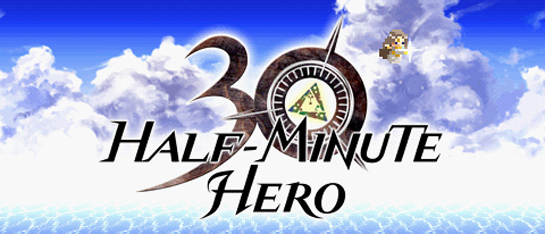
Tell us about Half-Minute Hero
Half-Minute Hero is an RPG that you can clear in thirty seconds. When it comes to Japanese RPGs, you usually take thirty, forty, fifty hours to beat them. With Half-Minute Hero, I wanted to create a game that even if you’re busy or if you don’t have much time, you can actually clear. It’s not just an RPG – it contains different types of games too, including a shooter and an RTS. So, as a whole, you get a lot in one package.
How are those games separated?
The story takes place over the course of five hundred years. In each period you have a different hero. So, first you have Hero 30, which plays as an RPG. Next is Evil Lord 30, the RTS part. After that you have Princess 30, which is a shooting game. For each period, a new hero is born and tries to save the world. Storywise, everything is linked together.
In the beginning of the game you can choose to play Hero 30, Evil Lord 30, or Princess 30 – you can actually start in any order you want. After clearing those three modes [Knight 30] will open up and you will be able to play that.
Which of those is the main game?
The main game is Hero 30, the RPG part. But it’s not just “clear the four modes and it’s over” – you can expect more once you clear them.
If someone has only seen the trailers, he or she might get the impression that all you have to do is push forward. How does strategy come into play?
When you play the game, you’ll see that it’s not all about just moving forward. You actually have to go into villages to unlock events, get health, and talk to people. Strategy comes into play as you find, discover, and figure out where to go and how to get there with the time that you’re given. You aren’t just leveling up and going up to the boss. You’re doing everything that you do in the course of a regular RPG in thirty seconds. If you’re just leveling up you will see that you will not be able to defeat the final boss.
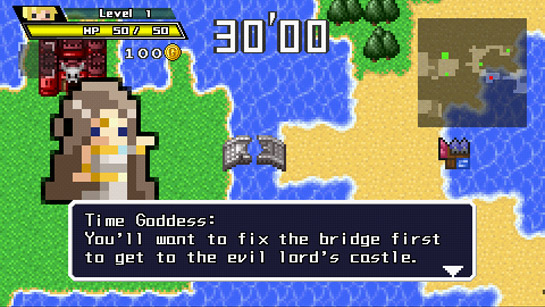
I noticed that once you beat a boss, you see the credits. What is that about?
You see the credits because in this game, clearing one stage is equivalent to clearing one RPG…
So how long is the game?
This isn’t just a thirty second game like everyone thinks – it’s actually really long. Depending on how you clear the game, you can unlock new things, new options, and with those new modes you can expand the playtime considerably. You also have time attacks and there’s an ad hoc mode where you can play against your friends.

How does multi-player work?
You can have four players playing at the same time, with each trying to beat the final boss. Each is going to try to level up quickly and do whatever it takes to get to and defeat the final boss. At the same time, the other players can try to bother and stop each other.
Can you describe the other three modes?
When you play Hero 30, you have to think about which strategy to use, what to do, and where to go first. With Princess 30, you have the princess, she has a bow, and she can shoot. She always has to go out and pick something up and try to get back to her castle within her thirty second curfew. It’s a simple shooter.
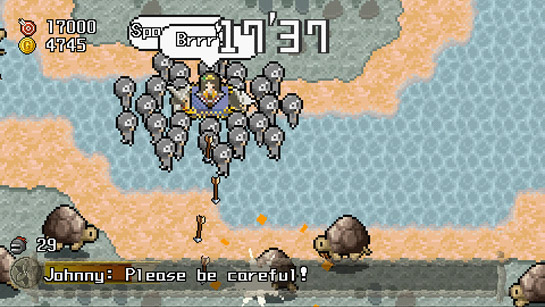
Does she fly?
Because she’s the princess, she doesn’t need to walk. She’s just on a chair and you have some soldiers holding the chair for her. That’s how she moves. But maybe if you go further into this mode you’re going to find out that maybe she can actually fly.
The RTS mode?
It’s called Evil Lord 30. The evil lord creates monsters that fight for him. It’s a little strategy game that uses [rock, paper, scissor-like] mechanics.
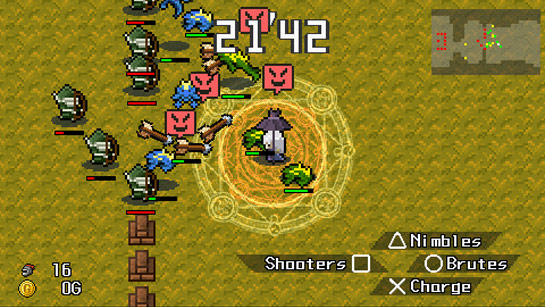
And the last one?
The last mode is Knight 30. It features a rookie knight that has to protect a sage, but since he’s really weak, the only way he can protect him is by using his own body to push the monsters away. By doing this the knight will sometimes die, but as long as the sage is still alive, he can come back to life. Through re-spawning and pushing monsters away, he has to protect the sage for thirty seconds.
How did you come up with the concept for Half-Minute Hero?
At first, I wanted to create an RPG that uses 8-bit retro-style graphics. I contacted a developer who I used to work with (Kotaro Yoshida, aka UUE) to try to get some ideas from him. His hobby is to make games, and he actually had a small prototype of Half-Minute Hero. When I saw it I thought “wow, that’s a great idea.” So we decided to make it into a proper game.
Why the 8-bit-looking graphics?
Having nice, epic illustrations alongside 2D 8-bit graphics created a gap that was actually kind of fun, so that was actually on purpose – we wanted to have those epic illustrations with those tiny little cute 2D characters.
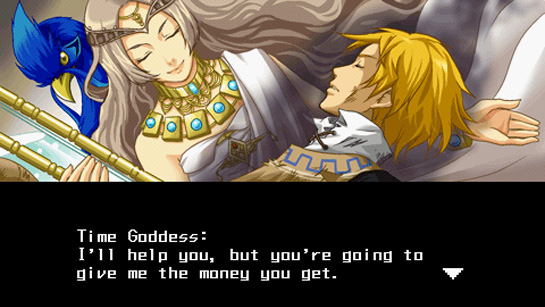
That’s all I have for Half-Minute Hero, but before we move on to some of your other games, was there anything else that you wanted to say about it?
For all those players who are kind of sick of Japanese RPGs that take way too long to finish, this is the perfect game for you. And even if it centers around thirty second games, that doesn’t mean that it isn’t deep. There’s a lot of stuff that you can do and you can enjoy it whenever and wherever you want, so please give it a try.

It’s a game developed by Audio Inc. They were behind Contact on the DS. It’s an adventure game that takes place in Japan. It has a traditional, nostalgic feel too it, especially for those who grew up in Japan.
What is the story about?
In a city somewhere in Japan, you have a sakura tree. Usually, after the spring, sakura trees lose all of their flowers. But this particular tree, even after spring, during the summer – it’s still pink with flowers on its branches. A boy in the city is suddenly approached by a strange old man who tells him that the sakura tree will die unless he helps him. From there, the story takes off with the hero trying to find a way to save the tree.
How does the game play?
You play this boy in the city – you’re hanging around, trying to find some hints as to the whereabouts of some monsters that are the reason why the sakura tree is actually dying. You do this by finding hints and talking to people. Once you’ve gathered all the hints and you know where to go, you go there and you fight against some monsters. For the most part, the battle parts are pretty simple – you press a to hit and b for defense. What you’re trying to do is make the monsters cry since their teardrops are what you need to save the sakura tree.
Is there anything else you wanted to add?
I would like to add that we have some very talented people working on this project. We have Uematsu-san (Nobuo Uematsu) for the music. For the scenario we have Nogima-san (Kazushige Nojima). Both worked on the Final Fantasy series. And we also have Minaba-san (Hideo Minaba) who was a character designer for the Final Fantasy series as well.
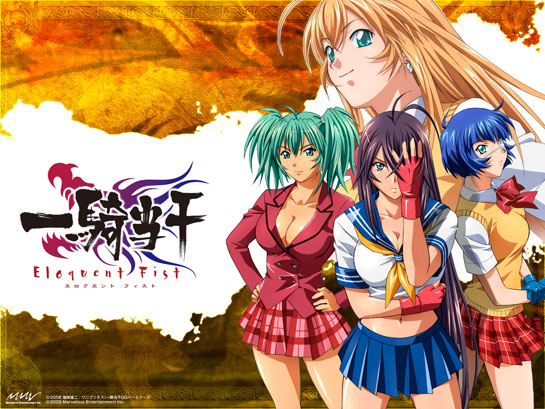
What was it like making an Ikki Tousen game?
First, personally, what you need to know is that I’m a really big huge fan of Ikki Tousen. Especially for the PSP version, when I worked on it, I really worked on it as a fan of the series.
So did it turn out exactly how you wanted it?
It turned out more or less what I had in mind.
Is there anything that you wanted to add but couldn’t?
Of course, when you have the original concept, you try to have it as close to that as possible. But even I know that you can’t have everything each time. But I’m satisfied with the result even after looking at the original concept we had in the beginning.
It looks like our time is up. Is there anything you would like to say before we go?
To all the Ikki Tousen fans out there, if you want the PSP version released in the US, please raise your voice!
Related posts:
]]>

Sarisa: Oh, don’t play dumb with me. you just grabbed my…
Sarisa: …
Sarisa: AaiiiEEE! What-what-what is that? It’s all long and… T-tentacles?!
This is not okay!
Sarisa: Hey! That is off limits! Ah! Ah ha ha! Ah ha ha ha! Stop it! Th-That
tickles! I-I’m gonna pee!
[Player Response]
Sarisa: [Player name]?! Help! Hurry, it’s… it’s… Ah ha ha haa ha ha ha!Kai: Quit messing around, [Player Name]! This is serious!
Sarisa: Huff… Pant… Th-Thank you, Kai. I’m fine.
Sarisa: Ugh, but it’s all sticky where that thing grabbed me!
credit: Tiny Cartridge
Related posts:
]]>
EVANGELION 1.0: You Are (Not) Alone is coming 11/17!
Until then, you can see the first nine minutes of this animated sci-fi action-thriller by Hideaki Anno here: http://www.funimation.com/evangelion/.
OR here: http://www.youtube.com/watch?v=1YFIAVsMNws – in HD!
Created by the same production team behind the hugely successful Neon Genesis Evangelion series, EVANGELION 1.0: YOU ARE (NOT) ALONE is a futuristic tale which tells the story of schoolboy Shinji Ikari as he is summoned by his estranged father to the vast city of Tokyo-3. The tearful reunion he was hoping for does not materialize as his father has a far more nefarious reason for wanting his son by his side again. Led down into the underground labyrinth of NERV headquarters, he learns that he is one of only a few children that can pilot one of the enormous Evangelion robots against a terrifying enemy. Tokyo-3 is under attack from the terrifying Angels, creatures of an unknown origin bent on laying waste to anything they find. However, there are greater forces at work behind the scenes, and is the true enemy the angels, NERV, the mysterious SEELE, or the demons held within the hearts of the people involved?
Related posts:
]]>
Dragon Ball: Raging Blast (360, PS3)
Final Fantasy XI: Vana’diel Collection 2 (360, PS2, PC)
Japanese History DS
J-League Pro Soccer Club o Tsukurou! 6: Pride of J (PSP)
Uchi no 3 Shimai DS 2: 3 Shimai no Dekake Daisakusen
Warship Gunner 2 Portable (PSP)
World History DS
0D Beat Drop (360 download)
Arcade Shooting Gallery (Wii)
Braid (PS3 download)
Buck Fever (Wii)
Buzz! Quiz World (PS3)
Call of Duty: Modern Warfare 2 (360, PC, PS3)
Call of Duty: Modern Warfare Mobilized (DS)
Call of Duty: Modern Warfare Reflex (Wii)
Dora the Explorer: Dora Saves the Crystal Kingdom (PS2)
Dragonology (DS)
Encleverment Experiment (360 download)
Excitebike: World Rally (Wii download)
Fairyland Melody Magic (DS)
Final Fantasy XI: Ultimate Collection (360, PC)
Gardenscapes (PC)
Hasbro Family Game Night (360)
Jonas (DS)
Kenka Bancho: Badass Rumble (PSP)
NBA 2K10 (Wii)
Petz Nursery (DS)
Pro Evolution Soccer 2010 (PS2, PSP, Wii)
Ringling Bros. and Barnum & Bailey Circus (DS, Wii)
Shaun White Snowboarding: World Stage (Wii)
Smart Kids Journey to Adventure (Wii)
Style Lab: Jewelry Design (DS)
Style Lab: Makeover (DS)
Team Elimination Games (Wii)
Teenage Mutant Ninja Turtles: Arcade Attack (DS)
Wedding Dash (DS)
WorldShift (PC)
Related posts:
]]>
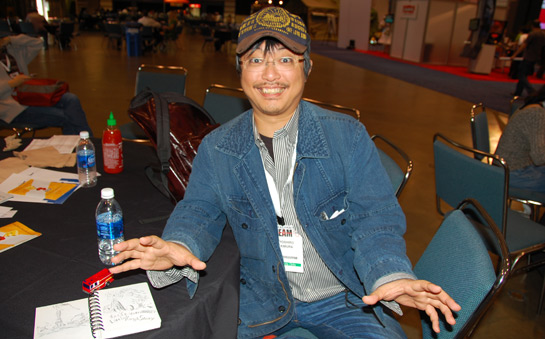
A few weeks ago at E3 I had another chance to talk to Kimura about Little King’s Story. Last time he talked about the story and play mechanics as well as what he did to set the game apart from the competition. This time around, he covered the music selection, how he came up with some of the game’s unique characters and creatures, the US version’s new mode, and much more. Because this is a follow-up interview to the one that I did at TGS last year, you might want to read that before continuing as I did not bother to repeat any of the questions that I had previously asked.
Note: This article is made up of two parts – an interview in which Kimura talks Little King’s Story followed by his account of what got him to start working on the game in the first place.
All the gaming maniacs of the world. I wanted to create something that even players that play realistic looking games can play and enjoy.
How about the hardcore gamer? Why should he or she care?
[Little King's Story] looks like a cute title, but its pretty action oriented at times. In the boss fights, for example, you really have to get into it. So, as a core gamer, you’ll have more of an advantage over the casual crowd; it’ll be easier to play. And for this version, unlike the European one, we’ve implemented a super hard mode called Hell Mode.
Note: Hell Mode was renamed Tyrant Mode in the US.
Tell us about Hell Mode.
Hell Mode is a higher difficulty option that is only available when you finish the regular modes. In it, the enemies are super strong and the citizens are really weak. Also, something special happens to the bull named Pancho, the one that Howser rides on, in Hell Mode only. The ending will also change a little bit and you will feel like you’ve accomplished something if you beat it.
I was looking at some videos and screenshots of the game and I saw some enemies that are pretty… unique, I’d say. How did you come up with them?
I just look at things sometimes and all these ideas start popping into my head. Even something like this pet bottle or this fire engine [points to a water bottle and mini fire engine on the table]. It’s like – “wouldn’t it be interesting if there’s a little creature living inside this pep bottle or something?” Any time I have that kind of epiphany or idea I jot it down in a notebook and I show it to my character designers and from there they start creating stuff for me. I used the same process when thinking about Little King’s Story – all this stuff popped into my mind so I started drawing things on paper. Right now, this is something that I’m trying to put together in my mind [Kimura opens his notebook and shows me a drawing]. It’s a werewolf, but he has bad legs, so when he’s chasing after you he uses a wheelchair that’s super fast.

So are we going to see that character in a future game?
Most likely…
So the character designers for Little King’s Story – Kurashima-san (Tingle’s Rosy Rupeeland, Super Mario RPG) and Minaba-san (Final Fantasy XII) – they are really talented and they come up with funny ideas, and one of the ideas they came up with was to make all of the enemies vegetables. At first I thought it was funny, but later on I decided “yeah, let’s not go that way…” However, in certain areas, you’ll see a lot of vegetable-looking animals, and that’s kind of a throwback to that earlier concept.
How about the flying cows? How did those come about?
They don’t really fly, but they do have wings. Those are called the wild cows. Basically, it’s an evil version of the regular cow. How that happens is these small creatures called Onii make these evil pickles. I call them “ganja pickles” [laughs]. When the animals or plants eat them or come in contact with them, it makes them evil. Going back to what I said about Pancho the bull earlier, there’s a connection between him and his family and the pickles that will be unveiled in Hell Mode.
I don’t know if the other places can really write “ganja pickle,” but that’s what I call them. You are free to use that if you want. That was what I had in mind. I wanted to push that name forward, but… So even after localization is done, I’m going to keep pushing it so people will start calling them “ganja pickles.”

Alright, I’ll call them that.
Thank you!
Tell us about the game’s music.
I chose to use mainly classical music since a lot of people don’t listen to it that much any more. I don’t believe that it’s rigid if you really listen to it; it’s really relaxed and mellow.
The funniest thing that I’ve noticed is that when people hum classical music, they often forget the middle portion because they don’t remember the melody. When I’ve called my staff members over and asked them to sing that song from Beethoven, they’ll start going [Kimura hums the intro for Beethoven's Symphony No. 5], but in the middle, they forget how the melody goes and they start making things up. To me, that’s really humorous and cute, so I actually put that element into Little King’s Story – in the middle of the night, you can talk to the citizens and sometimes they’ll be humming songs incorrectly.
Shimomura-san (Kingdom Hearts, Super Mario RPG) is the composer who put a lot of effort into arranging some classical music in a techno and rock style. So there are forty songs that are perfectly arranged by professionals – they’re real classic songs rearranged the Little King’s Story way. But for the twenty secret ones, I actually asked my foreign friends – a lot of different people from places like Russia, Korea, Germany, Holland, and Italy to name a few – to come in. When they went into the recording booth I told them “ok, remember that song? Hum it so we can record it and put it in the game.” Usually, when I ask them to do a specific song, two to three seconds are fine, but from thereon they completely forget how the melody goes, but I’ll be in the booth saying “keep singing, keep singing,” so they have to come up with their own melody to match what they think the song is supposed to sound like. So there are around sixty songs, but there are about twenty that you actually have to find that are a little off and not completely true to the originals.
How do you find these secret ones?
Going a little bit into the gameplay a little – there are seven kingdoms around yours. Each kingdom has a secret jar, and within each jar there is a princess. And when you defeat the other kingdoms you get those jars and are able to open them up to get the princesses. They all want you to get something for them, and one happens to love music. So when you talk to her it’s like – “I want to listen to these types of songs,” and that’s when the song-finding event is unlocked.
So all the princesses are selfish; they’re demanding and they want something, and you’re supposed to provide them with whatever they want. But the payoff is that by doing so they all become your wifes.
So how do you have seven wives?
[jokingly] What’s wrong with that? [laughs]
Can you describe the kingdoms?
There is one kingdom where the king thinks that whoever can eat the most sweets is the noblest person. The king in the kingdom of the jolly believes that whoever can drink the most is the best. Though he talks about world peace, he often becomes really wild and starts attacking people when he’s drunk. There is the land of the tall – whoever is the tallest or whoever is at the highest point is the noblest. There’s the land of the TV where it’s said that whoever watches the most is the most important person. Since he used to be a producer, he wants to cause war because that would provide him with more things to film, which would mean more programs for people to watch. There’s a kingdom where people are constantly thinking, so whoever thinks the most is the most noble. But their king has a dilemma – on the one hand, he has so many problems and concerns, and by solving them, he will be noble in one way. On the other hand, solving those problems allows him to think more, which means he will be noble in another way. So what happens when he solves all of the problems?
As you can see, each kingdom and king has its own idea of how to be the best, how to be the noblest. So as a player, you can go through all those kingdoms and try to figure out what it means to be noble. That’s the question that I’m asking the player.
So are gamers supposed to be learning a moral lesson by playing this?
It’s not necessarily a morality lesson or anything like that. It’s more like – in regular everyday life, you interact with a lot of people. You may think some people are dumb, some people are stupid, some people are smart, and some people are worth your admiration. So in a way, you don’t have to watch television or movies to be inspired, to find interesting people. You can find them by looking around nearby places like your neighborhood and trying to observe the people you find and understand what they’re going through – try to learn something from there. More than just playing a video game, it’s interesting to look at other characters and see what they’re thinking and try to learn what makes them who they are. Of course, while making this game, I really wanted to compete against those natural regular people who are interesting, so I made sure that the bosses were quirky, irregular characters.
Are these characters based on people that you know?
Yes. There’s the kingdom of the jolly king Duvroc – I got the inspiration for him from a drinking bar place that I go to in Tokyo. Everybody in that bar that I know – they’re funny and they’ll talk about something serious for three minutes. Then, a few seconds later, they’re going wild and having a tantrum and yelling at each other. That was where I got the idea for Duvroc.
I got the inspiration for Howser Oreganostein, the bull knight advisor who found Corobo, from my friend in Switzerland. His name is Hafis, he works on contemporary arts, he’s 70, but he’s really young at heart. He over-exaggerates everything, so the way he describes stuff is so interesting and funny. So I took a mental note of that and made Howser out of him.
So basically, what I’m trying to say is – yeah, all the interesting characters that are in the game are based on people who have influenced my life in one way or another.
So you’ve read the reviews for your game already. What do you think about the response so far?
A lot of reviews from European sites have already come out. The scores have been really high, especially from a place called Edge. They’re known for really being harsh with their scores, but we got a really high one from them, so I’m really proud of how Little King’s Story turned out. I’m especially happy about Edge’s score because they concentrate on core games. Not only that, but the games they do need to be really interesting or have that something else for them to appreciate it.
Of course, I’m not fully happy with what I did. I can never be 100% happy with what I create. I always get the feeling that “I should have done it this way” or “maybe this would have been better.” So it’s always a learning experience.
Care to elaborate on that?
This game used to have a 2-player mode, but we couldn’t make the QA and debug in time, so we had to take it out. And this is one of the things that I really wanted to have. But if Little King’s Story does well and a lot of people get to play it and if I have a chance to make a sequel, that’s definitely something I want to implement.
So, there’s definitely a possibility then?
There is a possibility in everything, but really – it’s up to the US gamers to play the game and support us.
I have one more question – what can you tell us about your next project?
There isn’t anything that I can really reveal right now. Yeah, I can’t really talk about the next project, but every day I do come up with new concepts and new ideas to create something new. I’ll play around with all these small ideas and try to make it into a concept for a new game.
Prologue: “A friend of mine suggested that I tell other people what I am about to say, but I quickly responded that ‘if I say it, people will think I’m really strange.’ So, I haven’t told too many people.”
Yoshiro Kimura on what motivated him to work on Little King’s Story -
I usually put my heart and soul into my projects, which often leaves me exhausted and burned out at the end. So, after the completion of a game, I traditionally take long breaks to unwind. Accordingly, after finishing the project that came right before Little King’s Story, I took three months off and went to Switzerland.
During my stay, I would often go on daily hikes in a forest close to where I was staying. This particular forest was really beautiful – it’s really misty and there’s a river that runs through it, and I usually find myself just walking around for thirty minutes at a time. Now, before I go on, I must say that I am not one to get high on anything or get completely drunk or wasted when drinking. In fact, I was completely sober during the following event -
One day, while on one of my hikes through the forest, I spied a squirrel that had just popped out. It was holding a chestnut or some other kind of seed, and was working on getting it open. And – true story – when it cracked it open, it looked directly at me and said “I’m busy! Leave me alone!”
Actually, this wasn’t the first time something like this has happened. The first was about fifteen years prior, about a year after I joined Square. I was twenty-four at the time. I travel and go backpacking a lot, and I just happened to be on a small island close to Tokyo. It’s a really small island where one can pretty much get around by just walking. At one point I was really sleepy, so I decided to lie down and take a nap on the side of a road. That’s when I noticed an eagle flying over my head. Suddenly, it came directly at me and right at the last second it flapped its wings, stopped, and said “welcome” in English before flying off. When I got back, I told people that “during my break I spoke to eagles.” Of course, nobody believed me, so I decided not to tell that particular story any more.
Now, I know what you’re thinking, but I truly believe that that squirrel talked to me. I’ve spoken to others about this and I actually met two people that assert that they had spoken to an animal as well, so I think that you really can communicate with animals.
Back to the story – the squirrel got the seed open, he looked at me, and said “I’m busy, leave me alone!” Though I was really surprised, I found that I wanted to say something back, so I responded with “I’m busy making games!” This was actually a turning point in my life. I thought – “oh, I should actually create more games since I made a promise to the squirrel.” In the past, every time I finish a game, I usually think something along the lines of “ok, that’s the last game I’m ever going to make.” Whenever I get to the end I think “that’s enough, I’ve done everything I can.” The same thing happened right before Little King’s Story. But because of the squirrel that I encountered, I had the energy to go back up to Wada-san, one of heads at Marvelous, and ask, “you want to make something together again?” And the rest is history…
Did either the squirrel or the eagle make it into Little King’s Story? If not, are they going to be in a future game?
I didn’t put it in Little King’s Story, but I do have a lot of appreciation for that squirrel, so when I do put it into a game I want it done in a good way…
Related posts:
]]>
In Little King’s Story you play as Corobo, a boy who, thanks to a magic crown that he found, is able to get others to do his bidding without fuss. With the help of his subjects, Corobo tries his best to expand his kingdom and make all of its inhabitants happy.
The game contains a mixture of simulation, adventure, and real-time strategy elements. While Pikmin may come to mind upon first glace, there is actually much more to it. Last month at Tokyo Game Show I had a chance to talk to producer Yoshiro Kimura about Little King’s Story. Here is what he had to say about the game – it’s story, play mechanics, and how it sets itself apart from the competition – as well as how his past experiences influenced its development.
Some of our readers may not know who you are and what you do. Can you give us a little rundown?
I’m a producer at Marvelous Entertainment. The past titles that I worked on are Chulip, moon, and a game called Rule of Rose – a horror action game. At the beginning, I started working with Wada-san on Chulip. The first project I started on when I came to Marvelous was No More Heroes with Wada-san and Suda-san. Now I’m working with Wada-san on Little King’s Story. I’m sorta like the producer/director.
To go back a little bit, in the very beginning, I really wasn’t interested in making any games. Back in the day, I was traveling around the world a lot, taking photographs, and writing a lot too. I really can’t think of any places I haven’t been to. I’ve been to Africa, Peru, America, Alaska. I’ve been in a lot of life-threatening situations too. One time I was attacked by mountain pirates and had everything stolen. Around [the development of] Chulip was the time that I started really making games.
I haven’t talked like this in a while. I’m happy that I’m talking about myself right now. Actually, I just remembered why I started liking games. When I was traveling in Peru, there was this one mountaintop that was really secluded. It was this really poor village – they were basically living in tents. But there was this one guy that had around five Super NES games. And he was charging a dime or a cent just to play for a certain amount of time. There was this huge line full of kids. Back in the days I used to work at Square, but looking at kids playing Final Fantasy or Super Mario really made me realize that Japanese gaming was amazing, that it’s giving entertainment to all these people in a secluded area. So that really changed my life.
How did those experiences influence Little King’s Story?
I haven’t really talked about this with anybody; even my development team doesn’t really know about this. Traveling around the world was a huge factor in Little King’s Story because I have so many friends around the world. One thing that I hate is war. There’s always a war happening in some part of the land and there are actually a couple of my friends who have lost their lives in war. In a way, I wasn’t happy with the US because it is always participating in war in some way, but one time when I visited it I received a culture shock. On one side there’s this entertainment business mindset where they want to make people happy or entertained in one way, and there’s this other side where they’re constantly going to war. So, one of the things that I wanted to think about is – there’s always fighting but there’s always laughing in the world. So maybe having a country conquering another country, making that not too serious, but more comical and more cute, could make a difference too.
So, for example – No More Heroes – it’s really gory – you see blood gushing out – but at the same time there’s a lot of humor in it. It’s not too grotesque. It’s the same thinking with Little King’s Story – all the characters are cute, but the basic concept is that you’re conquering different lands.
One of the things in Little King’s Story is there’s different kingdoms, and each kingdom has a unique perspective on life. If you go to one of the lands there’s this king that says that “I’m the noblest king because I can drink more than anybody else in the world.” If you go to another place there’s a king that says that “I’m the greatest because I can eat more than anybody else.” There’s a guy that says that “I’m at the highest place in this world so I’m the greatest,” and another guy saying that “I provide TV to everybody, so that’s why I’m the greatest.” They all have different reasons for telling the other kingdoms that theirs is the greatest, and that’s why they’re picking fights with you.
Tell us about how the game plays.
Basically, you’re the king of this really small kingdom, you’re poor, and there are only a few people that live there. You can go up to them and recruit them, and once you recruit them, they will start to follow you in a line. What you do is you order them around, make them work. So sometimes you make them dig, and when you go in you can find treasures. Or if there is a rock you can order them to break it. So by breaking the rock you can go to another pass or another land. Or there are these animals called “UMA” – they’re monsters that roam around – you order them to defeat those animals. That’s a really simple version of what the game is about.
At the very beginning, there are these people that have no jobs. They’re called “carefree adults.” They like to eat, they like to sleep, and they like to just dance around but not work. There are a few people that are like “I don’t want to work, but I don’t mind going for a treasure hunt.” So you bring them over and you go on a treasure hunt, and that starts the game off.
Once you get enough treasure you’ll be able to create job houses, meaning you can build a shack so that you can train soldiers or you can build a farmer house, and by sending them in you provide them jobs, and as you progress through the game, more jobs will open up which will allow you to build more buildings for those jobs.
Each job has its own attributes. For example, soldiers – they’re good at fighting enemies, so when you send them off you’ll have an easier time defeating enemies. And farmers – they’re good at digging holes, so they can dig holes faster than others. The can also produce hot springs at certain locations.
One of the things that I wanted to emphasize in the game is that each citizen is an individual. For example, if there are farmers and you don’t recruit them, they have their own routines. So in the morning, they’ll get up, they’ll go to the farm, they’ll start digging or they’ll start working on their crops. Soldiers – they’ll roam around the castle or they’ll guard the cities. So if you’re not even playing the game, you’re just looking at what the people are doing, you can actually see that they’re living their own lives.
I read somewhere that if something were to happen to the NPCs, their families might be affected. Is that element still in the game?
Yes, but not in the sense of the family family, like you’ll have a father and a daughter… I’m not sure how much I can say about this, but what the hell? I’ll just say it – not as a family, like a typical father and daughter. But they live in the same house, and people do sorta die, but they don’t really die. They pop out somewhere and it’s like “oh, i thought you were dead,” but they really weren’t. Once in a while they really really die, and when that happens it does become a sad thing for the citizens, so they’ll have a funeral at nightfall. Also, people who were fond of him, if you go talk to them individually, you’ll see that they’re crying or saying something like “I’m so sad that he passed away” or something of that sort.
Little King’s Story seems to have a few RTS elements to it. Did you get inspiration from any games in that genre?
That’s a difficult question because I don’t play that many games. To be honest, I watch a lot of movies and I read a lot of novels, but I don’t really play that many games. I’m sure I’ve been influenced by other games, but I really can’t think of anything. If I were to see another game and try to use what I see, it just becomes a copy of that game and I really don’t want to do that. I always thought that originality is really important, so, based on that concept, if it looks like another game that’s been done before, I think that’s totally ok, but if it’s the other way around, like you like a game and you want to make something like that game, then it just doesn’t become original.
If I remember correctly, Chulip is a game where the character goes around kissing people. Did that element or any other things from Chulip make it into Little King’s Story?
In Chulip, individual characters had their own lives too, so you’ll see a lot of people sleeping, slacking off, fighting with each other, arguing – it’s like in a real city where they have their own lives. In Little King’s Story, they have their own lives too, but if the king comes up to you and says “we’re going to this place – you’re going to come along,” they have to throw down everything that they’re doing and just follow the king. It has a little bit of that ordering around aspect. It’s sad but funny put together. They have their own lives but you can order them around and bring them to fight or whatever.
Another thing – there are the carefree adults, people with no jobs. People who have jobs have been working. They have pride in what they do, so if there’s a farmer or soldier that sees a carefree adult, they look down upon them. So if there’s a soldier that’s walking around and there’s a carefree adult, the soldier will try to kick him, but at the same time, the carefree adult will retaliate by going to where the soldier will walk around and just sleep in his pathway. So it has a little bit of those elements as well.
When you scout people, do they always follow your orders?
There are people who don’t want to go to work, but you are the king so they have to follow your orders. So, even though they follow you around, you can go talk to them later on and then they’ll say “I really didn’t want to go but I had no choice.” Things like that. So when you talk to them, sometimes they’ll give you an evaluation of how good of a job you’re doing, so you talk and they’re like “yeah, you’re doing a 30% job right now.” They’ll give you their opinion on what’s going on.
Does morale come into play?
I didn’t want too many status elements because it makes it too complicated, so each individual character just has strengths, weaknesses, their own individual characteristics, but as a group they’ll always follow what the king is saying.
That’s all I have for now. Is there anything that you’d like to add about the game or something you want the readers to know about?
I live for “love, peace, and game players,” so as long as those three are there and everybody’s happy, I really want them to enjoy Little King’s Story.
Oh, one more thing – release date?
In the US it’s coming this winter. I’ll bring it out when everyone’s freezing over there. My message is to stay home and play games. Please look forward to it.
Related posts:
]]>

side note: I’ve heard that the spoken dialog in the Japanese release is all in English. If true, it may not be necessary to wait until the January domestic release to get the full experience if you import.
At this year’s TGS I was offered an interview with Yusuke Hashimoto, the producer for Bayonetta, since he happened to be available while I was waiting for another developer. It being a surprise interview, I had to come up with some questions on the fly as opposed to doing research ahead of time and coming up with more informed ones. Hopefully, I was able to get a few responses that you might find interesting -
Before we get started, can you tell us about yourself?
I’m Yusuke Hashimoto, a producer at PlatinumGames. The past titles that I’ve worked on were Biohazard 3 for the PS1, Biohazard and Biohazard 4 for the GameCube, Devil May Cry, and Godhand.
So you were the producer for those?
For Bayonetta it is my first time as a producer, but for those I was the designer.
What exactly did you do as the designer for Devil May Cry?
I was primarily the effects designer; I did all the special effects.
Tell us about Bayonetta.
Bayonetta is a witch who has been in a magical slumber. She has only recently awoken into modern times and has no memory of her past. She has the ability to summon forth demonic entities through her hair. They take shape as she uses them in her attacks. As you progress through the game, you learn more about her past and what she’s doing now as she adjusts to the modern world.
Is the main character’s design based on any person, character, or actress?
The original idea for Bayonetta – the character design – is the brainchild of Kamiya-san. But translating that into digital flesh within the game took the efforts of the lead character designer and the people who had to actually turn her into a reality from somebody’s mind’s eye. Since the lead character designer (Mari Shimazaki) is female, she had a lot of influence and gave a lot of very good advice on how to really make a feminine character. If it was just a man trying to create a female character, it’s going come off as really fake or kind of odd and just sort of out of place, but having a female character designer help out really benefited the look of the character, whether it be her makeup, her fashion, accessories, or those kinds of things.

How’d you come up with the name “Bayonetta?”
The name itself ties very closely to the core mechanics of the game. Basically, when you do the physical melee attacks – punching and kicking opponents – you follow up immediately with shooting. So she shoots when she punches, she shoots when she kicks. And that’s how a bayonet works – you attach it to the front of a weapon and you shoot and you stab with it. So we kind of latched on to that. We eventually realized that [Bayonet] is not very feminine, so we tried to make it more feminine by transforming it into Bayonetta.
Did the idea for the game come about while Devil May Cry was in development?
PlatinumGames came together about three years ago, and around that time Kamiya-san and the other Platinum directors were talking about what kinds of games they wanted to create. Kamiya-san and I had worked together on the original Devil May Cry, so I came to Kamiya-san and said “I want to see another one of your 3D action games. And that’s where that seed was planted. That seed eventually grew into Bayonetta. Because I pushed Kamiya-san into it, they made me the producer.
Were a lot of the concepts that were used in Bayonetta things that you thought were missing or should have been implemented in the Devil May Cry series?
It really wouldn’t be accurate to say that we’ve built the game to incorporate a lot of the things that should have been in any of the Devil May Cry games because when we sat down to make Bayonetta, we really sat down to make it from scratch. And we didn’t reference Devil May Cry or any of those other games to decide what kind of game we were going to make. We started off from zero and said “ok, we’re gonna make an action game. This is all the stuff that needs to be in there to make the best action game that we know how to make.” So, while Devil May Cry and the other games that we worked on gave us the experience and the know-how to make a game like Bayonetta, we never thought “oh, I wish we’d had this for that game” or anything like that. It’s “what are we making right now? Let’s focus on the here and now and the future.”
A lot of people are saying that Bayonetta is all about style over substance. What is your response to that?
First and foremost, Bayonetta is an action game for action game fans. So, there’s nothing for anybody to worry about when it comes to the depth of the game. It’s really a non-argument for Kamiya-san, myself, and the rest of the team – the experience we’ve gained making action games over the years really lent itself to the kind of game that Bayonetta is. We’ve built the kind of game that we as action fans want to play ourselves.
To take it one step further, we understand that there are other people that are not like ourselves – those who are not necessarily action fans, who have yet to become action fans. And so, keeping those people, the broader market, in mind as well, we’ve actually put in an easy mode where the combo moves are easy to pull off. They’re automatically enabled in easy mode, and so that’s for people who maybe are on the cusp of becoming real hardcore action fans or those who are not really interested in taking things to the extreme level but still want to get the full entertainment value out of it. So the game at its heart is for action fans and it’s going to be completely satisfying to any action game fan. But it’s also going to satisfy the people who aren’t necessarily action game fans.
Bayonetta comes out later this month in Japan and in January here in the US. If you want to find out more about the game, you might want to check out the PlatinumGames developer blog. It’s actually pretty cool and something that I wish more developers would do. At the very least, it’s a good read for those who need a distraction while waiting for the release.
Related posts:
]]>

Irvine, Ca. (November 5, 2009) – Atlus U.S.A., Inc. today announced Shin Megami Tensei: Strange Journey, a first-person science fiction RPG for Nintendo DS. A startlingly original entry in the award-winning Shin Megami Tensei universe, Strange Journey takes the heralded RPG franchise to exciting new frontiers. The game has already released in Japan to strong demand and critical acclaim, earning a 10/9/9/8 from Famitsu, the highest score the popular magazine has ever awarded a Shin Megami Tensei title.
In the near future, a mysterious, growing, black void appears at the Earth’s southern pole. Unable to determine its cause and powerless to stop its deadly encroachment, humanity sends an elite team of explorers into the heart of the phenomenon, just as Strange Journey’s look and feel represent a return to the heart of Shin Megami Tensei, bringing to mind the all-time classic Nocturne. With over 300 demons to bribe, coerce, and negotiate with to gain assistance in battle, Strange Journey is every bit the deep, rewarding RPG experience fans have come to expect from the SMT franchise, yet delivered with a fresh new sci-fi story that taps into mature themes of morality and introspection.
Shin Megami Tensei: Strange Journey for Nintendo DS is currently scheduled for release on March 10, 2010.
For more information, visit the official website: http://www.atlus.com/strangejourney
Related posts:
]]>
So, you’re currently working on a game called Sakura Note. Tell us about it.
It’s a game developed by Audio, Inc. They were behind Contact on the DS. It’s an adventure game that takes place in Japan. It has a traditional, nostalgic feel too it, especially for those who grew up in Japan.
What is the story about?
In a city somewhere in Japan, you have a sakura tree. Usually, after the spring, sakura trees lose all of their flowers. But this particular tree, even after spring, during the summer – it’s still pink with flowers on its branches. A boy in the city is suddenly approached by a strange old man who tells him that the sakura tree will die unless he helps him. From there, the story takes off with the hero trying to find a way to save the tree.
How does the game play?
You play this boy in the city – you’re hanging around, trying to find some hints as to the whereabouts of some monsters that are the reason why the sakura tree is actually dying. You do this by finding hints and talking to people. Once you’ve gathered all the hints and you know where to go, you go there and you fight against some monsters. For the most part, the battle parts are pretty simple – you press a to hit and b for defense. What you’re trying to do is make the monsters cry since their teardrops are what you need to save the sakura tree.
Is there anything else you wanted to add?
I would like to add that we have some very talented people working on this project. We have Uematsu-san (Nobuo Uematsu) for the music. For the scenario we have Nogima-san (Kazushige Nojima). Both worked on the Final Fantasy series. And we also have Minaba-san (Hideo Minaba) who was a character designer for the Final Fantasy series as well.
Jigen Kairou (PSP)
Kobun Kanbun DS
Minna no Navi (PSP)
Namco Museum Virtual Arcade (360)
Rika-Chan DS Motto! Onna no Ko Lesson: Oshare Oshigoto Otetsudai Daisuki!
Suugaku Master DS
Tamagotchi no Narikiri Channeru (DS)
Tsunagete Pipemania (DS)
WireWay (DS)
World Soccer Winning Eleven 2010 (360, PS3)
A Christmas Carol (DS)
Academy of Champions: Soccer (Wii)
Agatha Christie: The ABC Murders (DS)
Band Hero (360, DS, PS2, PS3, Wii)
Barbie and the Three Musketeers (DS, Wii)
C.O.P. The Recruit (DS)
Dora the Explorer: Dora Saves the Crystal Kingdom (Wii)
Dragon Age: Origins (360, PC, PS3)
Dreamkiller (360 download)
Food Network: Cook or Be Cooked (Wii)
Football Manager 2010 (PC)
Ghostbusters: The Video Game (PSP)
Hidden Mysteries: Titanic – Secrets of the Fateful Voyage (DS, Wii)
Imagine: Babyz Fashion (DS)
Jak & Daxter: The Lost Frontier (PS2, PSP)
Jewel Master: Egypt (DS)
Jewel Quest Mysteries (DS)
Jurassic: The Hunted (360, PS2, PS3, Wii)
Lego Rock Band (360, DS, PS3, Wii)
My Baby: First Steps (Wii)
Need For Speed Nitro (DS, Wii)
Ni Hao, Kai-Lan: New Year’s Celebration (DS)
Pro Evolution Soccer 2010 (360, PS3)
Rabbids Go Home (DS, Wii)
Safari Adventures: Africa (DS)
Shaun White Snowboarding: World Stage (Wii)
Star Wars Battlefront: Elite Squadron (DS, PSP)
Star Wars: The Force Unleashed – Ultimate Sith Edition (360, PS3)
Style Savvy (DS)
Sushi Academy (DS)
Ultimate Party Challenge (Wii)
We Cheer 2 (Wii)
We Wish You A Merry Christmas (Wii)
WireWay (DS)
Related posts:
]]>
I played a bit of this at TGS and as far as I can tell, it plays pretty much like the original. According to NCSX, Genterprise’s DS port was supervised by Sakai Kiyoshi, the original programmer, so it looks like this is the version to get if you want Umihara Kawase in portable form.
When footage from Bayonetta was first shown at E3 2008 alongside MadWorld in PlatinumGames’ media room, it was introduced as a “cool and stylish action shooter.” My first impression after hearing that description and seeing the footage was that it looked a lot like Devil May Cry mixed with some Ninja Gaiden. It was only later that I found out that the game’s director, Hideki Kamiya, was the creator of DMC, so the similarities are somewhat understandable. However, it seemed like there was more to it than that, and at this year’s E3, I was able to confirm that my suspicions were correct – it’s more than just a DMC clone. The updated demo that we got to try at Tokyo Game Show last month was further proof of that. Luckily, those with Japanese accounts for both Xbox Live! and PSN will be able see it for themselves soon enough (possibly by the time this piece goes up). Whether or not the game holds up beyond what is presented in the demo is still unknown, but since it gets released in Japan in only a few weeks, we won’t have to wait that long to find out.
side note: I’ve heard that the spoken dialog in the Japanese release is all in English. If true, it may not be necessary to wait until the January domestic release to get the full experience if you import.
At this year’s TGS I was offered an interview with Yusuke Hashimoto, the producer for Bayonetta, since he happened to be available while I was waiting for another developer. It being a surprise interview, I had to come up with some questions on the fly as opposed to doing research ahead of time and coming up with more informed ones. Hopefully, I was able to get a few responses that you might find interesting -
Before we get started, can you tell us about yourself?
I’m Yusuke Hashimoto, a producer at PlatinumGames. The past titles that I’ve worked on were Biohazard 3 for the PS1, Biohazard and Biohazard 4 for the GameCube, Devil May Cry, and Godhand.
So you were the producer for those?
For Bayonetta it is my first time as a producer, but for those I was the designer.
What exactly did you do as the designer for Devil May Cry?
I was primarily the effects designer; I did all the special effects.
Tell us about Bayonetta.
Bayonetta is a witch who has been in a magical slumber. She has only recently awoken into modern times and has no memory of her past. She has the ability to summon forth demonic entities through her hair. They take shape as she uses them in her attacks. As you progress through the game, you learn more about her past and what she’s doing now as she adjusts to the modern world.
Is the main character’s design based on any person, character, or actress?
The original idea for Bayonetta – the character design – is the brainchild of Kamiya-san. But translating that into digital flesh within the game took the efforts of the lead character designer and the people who had to actually turn her into a reality from somebody’s mind’s eye. Since the lead character designer (Mari Shimazaki) is female, she had a lot of influence and gave a lot of very good advice on how to really make a feminine character. If it was just a man trying to create a female character, it’s going come off as really fake or kind of odd and just sort of out of place, but having a female character designer help out really benefited the look of the character, whether it be her makeup, her fashion, accessories, or those kinds of things.
How’d you come up with the name “Bayonetta?”
The name itself ties very closely to the core mechanics of the game. Basically, when you do the physical melee attacks – punching and kicking opponents – you follow up immediately with shooting. So she shoots when she punches, she shoots when she kicks. And that’s how a bayonet works – you attach it to the front of a weapon and you shoot and you stab with it. So we kind of latched on to that. We eventually realized that [Bayonet] is not very feminine, so we tried to make it more feminine by transforming it into Bayonetta.
Did the idea for the game come about while Devil May Cry was in development?
PlatinumGames came together about three years ago, and around that time Kamiya-san and the other Platinum directors were talking about what kinds of games they wanted to create. Kamiya-san and I had worked together on the original Devil May Cry, so I came to Kamiya-san and said “I want to see another one of your 3D action games. And that’s where that seed was planted. That seed eventually grew into Bayonetta. Because I pushed Kamiya-san into it, they made me the producer.
Were a lot of the concepts that were used in Bayonetta things that you thought were missing or should have been implemented in the Devil May Cry series?
It really wouldn’t be accurate to say that we’ve built the game to incorporate a lot of the things that should have been in any of the Devil May Cry games because when we sat down to make Bayonetta, we really sat down to make it from scratch. And we didn’t reference Devil May Cry or any of those other games to decide what kind of game we were going to make. We started off from zero and said “ok, we’re gonna make an action game. This is all the stuff that needs to be in there to make the best action game that we know how to make.” So, while Devil May Cry and the other games that we worked on gave us the experience and the know-how to make a game like Bayonetta, we never thought “oh, I wish we’d had this for that game” or anything like that. It’s “what are we making right now? Let’s focus on the here and now and the future.”
A lot of people are saying that Bayonetta is all about style over substance. What is your response to that?
First and foremost, Bayonetta is an action game for action game fans. So, there’s nothing for anybody to worry about when it comes to the depth of the game. It’s really a non-argument for Kamiya-san, myself, and the rest of the team – the experience we’ve gained making action games over the years really lent itself to the kind of game that Bayonetta is. We’ve built the kind of game that we as action fans want to play ourselves.
To take it one step further, we understand that there are other people that are not like ourselves – those who are not necessarily action fans, who have yet to become action fans. And so, keeping those people, the broader market, in mind as well, we’ve actually put in an easy mode where the combo moves are easy to pull off. They’re automatically enabled in easy mode, and so that’s for people who maybe are on the cusp of becoming real hardcore action fans or those who are not really interested in taking things to the extreme level but still want to get the full entertainment value out of it. So the game at its heart is for action fans and it’s going to be completely satisfying to any action game fan. But it’s also going to satisfy the people who aren’t necessarily action game fans.
Bayonetta comes out later this month in Japan and in January here in the US. If you want to find out more about the game, you might want to check out the PlatinumGames developer blog. It’s actually pretty cool and something that I wish more developers would do. At the very least, it’s a good read for those who need a distraction while waiting for the release.
Tekken 6 (360, PS3)
Tsumi to Batsu Uchu no Koukeisha (Wii)
NadePro!! Kisama no Seiyuu Yatte Miro! (PS2)
Date ni Game Tsui Wake Jane! Dungeon Maker Girls Type (DS)
Konami Dendou Selection (DS)
100 All-Time Favorites (DS)
All-Star Cheer Squad 2 (Wii)
Arcade Shooting Gallery (Wii)
Are You Smarter Than A 5th Grader? Game Time (360, DS, Wii)
Ben 10 Alien Force: Vilgax Attacks (360, DS, PS2, PSP, Wii)
Borderlands (PC)
Chronicles of Mystery: Curse of the Ancient Temple (DS)
CSI: Deadly Intent – The Hidden Cases (DS)
CSI: Deadly Intent (360, Wii)
Dance Dance Revolution Hottest Party 3 (Wii)
Dance Dance Revolution X2 (PS2)
Diner Dash: Flo on the Go (DS)
DJ Hero (360, PS2, PS3, Wii)
Dora Puppy (DS)
Drawn to Life: The Next Chapter (DS, Wii)
Dream Salon (DS)
Fairytale Fights (360, PS3)
Forza Motorsport 3 (360)
Grand Theft Auto IV: The Ballad of Gay Tony (360 download)
Grand Theft Auto: Episodes from Liberty City (360)
Hasbro Family Game Night (DS)
Hasbro Family Game Night 2 (Wii)
iCarly (DS, Wii)
Madagascar Kartz (360, DS, PS3, Wii)
Monster 4×4: Stunt Racer (Wii)
Mountain Sports (Wii)
Nerf N-Strike Elite (Wii)
Ni Hao Kai Lan: Super Game Day (PS2, Wii)
Painkiller: Resurrection (PC)
Petz Dolphinz Encounter (DS)
Petz: Dogz Family (PSP)
Petz: Hamsterz Bunch (PSP)
Petz: Saddle Club (PSP)
Press Your Luck: 2010 Edition (DS, PC, Wii)
Ratchet & Clank Future: A Crack in Time (PS3)
Safari Adventures: Africa (Wii)
Saw (PC)
SimAnimals: Africa (DS, Wii)
Ski-Doo: Snowmobile Challenge (Wii)
SpongeBob’s Truth or Square (360, DS, PSP, Wii)
System: Flaw (DS)
The Backyardigans (DS)
The Stronghold Collection (PC)
Tinkerbell and the Lost Treasure (DS)
Torchlight (PC download)
Vegas Party (Wii)
Water Sports (Wii)
World of Zoo (DS, PC, Wii)
Zenses: Zen Garden (DS)
Related posts:
]]>


Related posts:
]]>
Related posts:
]]>

Related posts:
]]>